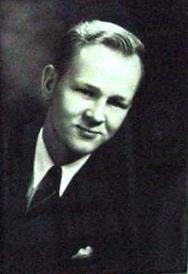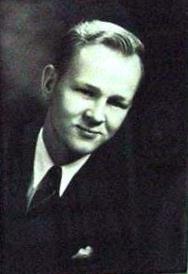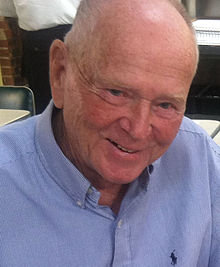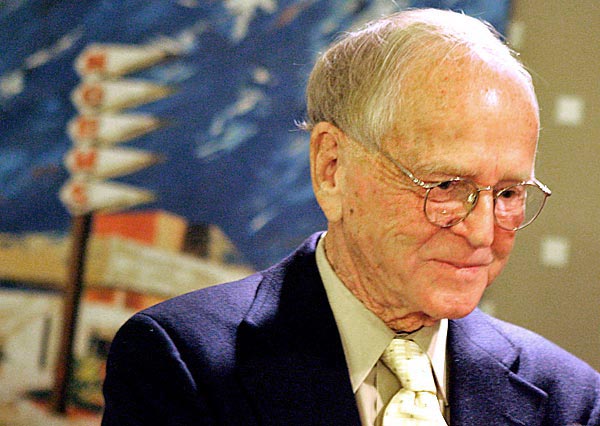"Eldo" as we affectionately referred to him, was a gentle soul, a very kind man, with the biggest, easiest smile that you've ever seen. His eyes literally twinkled!
Although Eldo received acclaim for his iconic architectural accomplishments, throughout his life he remained a humble man. He loved playing tennis and golf and he enjoyed the company of his children and grandchildren.
Widowed in the 1970s after being married for more than 30 years, Eldon married his second wife, Luana, in 1976.
Wikipedia entry:
Eldon Carlyle Davis was an American architect, considered largely responsible for the creation of "GOOGIE ARCHITECTURE", a form of modern architecture originating in Southern California. Googie architecture is largely influenced by Southern California's car culture and the Space Age of the mid-20th century. Davis was a founding partner of the Armet & Davis architectural firm which championed Googie architecture, including the original Norms Restaurant, a Googie coffee shop designed by Davis. For his work, the Los Angeles Times called Davis, "the father of the California coffee shop."
Eldon Davis was born in Anacortes, Washington in 1917. He originally worked at a fish cannery while attending the University of Southern California. He created a new design for the fish cannery as an architectural student, a design that was later built. Davis earned a bachelor's degree in architecture from the University of Southern California in 1942.
Davis and his business partner, architect Louis Armet, expected to work in industrial architecture following their graduation from USC. However, their plans changed thanks to the post-war construction boom in Southern California following World War II. They began designing structures geared towards a growing population, including nurseries, churches, country clubs, banks and even bowling alleys.
In 1947, Davis and Armet opened their architectural firm, Armet & Davis. Together, the architects used their firm and its designs to champion Googie architecture, especially in California. The firm exists today as Armet Davis Newlove Architecture and is headquartered in Santa Monica, California.
One of the best preserved examples of Davis's work is the Pann's coffee shop and its neon sign in Westchester, Los Angeles. Davis also designed the early prototypes for local Big Boy and Denny's restaurants in Los Angeles. The older buildings on the Fullerton campus of Hope International University also display Davis's classic Googie style.
http://www.laobserved.com/archive/2011/04/eldon_davis_icon_of_las_g.php
http://en.wikipedia.org/wiki/Armet_Davis_Newlove_Architects
∼By Valerie J. Nelson, Los Angeles Times
April 26, 2011
Eldon Davis, an influential architect known as the father of the California coffee shop for midcentury designs inspired by the Space Age and the region's car culture, has died. He was 94.
Davis died Friday at a West Hills hospital of complications from spinal meningitis, said his wife, Luana.
When America was in love with aerodynamic design, Davis devised a concept for Norms restaurant that made it appear poised for liftoff.
Built on La Cienega Boulevard in 1957, Norms had many features that came to typify the whimsical style of architecture known as Googie — a vaulted roof that resembles a flying wing, a room-length dining counter and an attention-grabbing vertical neon sign with roots in Las Vegas kitsch.
Photos: Eldon Davis and Googie architecture
With architect Louis Armet, Davis opened a local firm in 1947 and developed a reputation for being willing to try almost anything to catch the attention of motorists who sped by.
The architects were chief proponents of Googie, named for a now-defunct cafe in West Hollywood, and derided by critics in the 1950s and 1960s "who didn't think a lot of our work but we didn't care," said Victor Newlove, a partner in the firm who started as an intern in the 1960s.
With their soaring and exaggerated roof lines, their buildings appeared to defy gravity, a structural innovation for which Davis was largely responsible.
"We just did the best we could with the problem at hand," Davis told The Times in 1993. "We didn't want to do what had been done."
Neon signs became a trademark, and they devised an animated sign for Pann's, a coffee shop in Westchester. Run by the same family since it opened in 1958, the restaurant is probably the best preserved example of Davis' work, Newlove said.
"He would do things that other architects would not think of doing, which is the hallmark of a fine architect," Newlove said.
Other Davis designs include prototypes for local Denny's and Bob's Big Boy restaurants, blueprints that were exported across the country.
"They brought modern architecture to the daily life of the average Angeleno," said Alan Hess, who wrote the 2004 book "Googie Redux."
"There's a great deal of interest and affection for their buildings," Hess said. "The work of Armet and Davis is as significant to Southern California as Richard Neutra or Rudolph Schindler."
Other examples include what became Johnie's, a diner at Wilshire Boulevard and Fairfax Avenue with a roof line that folded downward; and the Wich Stand on Slauson Avenue near Inglewood with a tilting blue roof and needle-like spire.
"They didn't invent Googie style, but they defined it and refined it," said Chris Nichols, a former chairman of the Los Angeles Conservancy modern committee. "If you are trying to cover the 1950s in shorthand, you will always include their '50s-swoop masterpieces.... They are like science fiction."
Although Davis had a major role in popularizing what became known as Coffee Shop Modern, he was pragmatic about the lasting value of the more than 4,000 coffee shops his firm designed.
"I can't see why they'd try to preserve any of them," he told The Times in 1986. "We would have liked to have made them more aesthetic, but we were just designing them to sell hamburgers."
Born in 1917 in Washington state, Davis was working summers at a fishing cannery when he decided to design a better facility while attending USC as an architecture student. His concept was later built, The Times reported in 1964.
In the 1940s, he designed installations for the military and did similar work as a civilian for the Navy.
A 1942 graduate of USC, Davis expected to pursue industrial architecture with Armet but instead rode the crest of the postwar building boom, designing structures that included churches, banks, bowling alleys, country clubs and nurseries. Armet died in his late 60s in 1981.
"This end of the country was open to ideas," Davis said in "Googie Redux."
Widowed in the 1970s after being married for more than 30 years, Davis married his second wife, Luana, in 1976. The couple split their time between homes in Gig Harbor, Wash., and Woodland Hills.
In his early 80s, Davis retired but continued to run marathons until a couple of years ago.
"He was very spritely and always athletic," Nichols said. "He always had a grin and a little wink."
In addition to his wife, Luana, Davis is survived by a daughter, Karen of Oregon; three sons, Dan, Mark and Wyatt, all of the Los Angeles area; five grandchildren; and two great-grandchildren.
"Eldo" as we affectionately referred to him, was a gentle soul, a very kind man, with the biggest, easiest smile that you've ever seen. His eyes literally twinkled!
Although Eldo received acclaim for his iconic architectural accomplishments, throughout his life he remained a humble man. He loved playing tennis and golf and he enjoyed the company of his children and grandchildren.
Widowed in the 1970s after being married for more than 30 years, Eldon married his second wife, Luana, in 1976.
Wikipedia entry:
Eldon Carlyle Davis was an American architect, considered largely responsible for the creation of "GOOGIE ARCHITECTURE", a form of modern architecture originating in Southern California. Googie architecture is largely influenced by Southern California's car culture and the Space Age of the mid-20th century. Davis was a founding partner of the Armet & Davis architectural firm which championed Googie architecture, including the original Norms Restaurant, a Googie coffee shop designed by Davis. For his work, the Los Angeles Times called Davis, "the father of the California coffee shop."
Eldon Davis was born in Anacortes, Washington in 1917. He originally worked at a fish cannery while attending the University of Southern California. He created a new design for the fish cannery as an architectural student, a design that was later built. Davis earned a bachelor's degree in architecture from the University of Southern California in 1942.
Davis and his business partner, architect Louis Armet, expected to work in industrial architecture following their graduation from USC. However, their plans changed thanks to the post-war construction boom in Southern California following World War II. They began designing structures geared towards a growing population, including nurseries, churches, country clubs, banks and even bowling alleys.
In 1947, Davis and Armet opened their architectural firm, Armet & Davis. Together, the architects used their firm and its designs to champion Googie architecture, especially in California. The firm exists today as Armet Davis Newlove Architecture and is headquartered in Santa Monica, California.
One of the best preserved examples of Davis's work is the Pann's coffee shop and its neon sign in Westchester, Los Angeles. Davis also designed the early prototypes for local Big Boy and Denny's restaurants in Los Angeles. The older buildings on the Fullerton campus of Hope International University also display Davis's classic Googie style.
http://www.laobserved.com/archive/2011/04/eldon_davis_icon_of_las_g.php
http://en.wikipedia.org/wiki/Armet_Davis_Newlove_Architects
∼By Valerie J. Nelson, Los Angeles Times
April 26, 2011
Eldon Davis, an influential architect known as the father of the California coffee shop for midcentury designs inspired by the Space Age and the region's car culture, has died. He was 94.
Davis died Friday at a West Hills hospital of complications from spinal meningitis, said his wife, Luana.
When America was in love with aerodynamic design, Davis devised a concept for Norms restaurant that made it appear poised for liftoff.
Built on La Cienega Boulevard in 1957, Norms had many features that came to typify the whimsical style of architecture known as Googie — a vaulted roof that resembles a flying wing, a room-length dining counter and an attention-grabbing vertical neon sign with roots in Las Vegas kitsch.
Photos: Eldon Davis and Googie architecture
With architect Louis Armet, Davis opened a local firm in 1947 and developed a reputation for being willing to try almost anything to catch the attention of motorists who sped by.
The architects were chief proponents of Googie, named for a now-defunct cafe in West Hollywood, and derided by critics in the 1950s and 1960s "who didn't think a lot of our work but we didn't care," said Victor Newlove, a partner in the firm who started as an intern in the 1960s.
With their soaring and exaggerated roof lines, their buildings appeared to defy gravity, a structural innovation for which Davis was largely responsible.
"We just did the best we could with the problem at hand," Davis told The Times in 1993. "We didn't want to do what had been done."
Neon signs became a trademark, and they devised an animated sign for Pann's, a coffee shop in Westchester. Run by the same family since it opened in 1958, the restaurant is probably the best preserved example of Davis' work, Newlove said.
"He would do things that other architects would not think of doing, which is the hallmark of a fine architect," Newlove said.
Other Davis designs include prototypes for local Denny's and Bob's Big Boy restaurants, blueprints that were exported across the country.
"They brought modern architecture to the daily life of the average Angeleno," said Alan Hess, who wrote the 2004 book "Googie Redux."
"There's a great deal of interest and affection for their buildings," Hess said. "The work of Armet and Davis is as significant to Southern California as Richard Neutra or Rudolph Schindler."
Other examples include what became Johnie's, a diner at Wilshire Boulevard and Fairfax Avenue with a roof line that folded downward; and the Wich Stand on Slauson Avenue near Inglewood with a tilting blue roof and needle-like spire.
"They didn't invent Googie style, but they defined it and refined it," said Chris Nichols, a former chairman of the Los Angeles Conservancy modern committee. "If you are trying to cover the 1950s in shorthand, you will always include their '50s-swoop masterpieces.... They are like science fiction."
Although Davis had a major role in popularizing what became known as Coffee Shop Modern, he was pragmatic about the lasting value of the more than 4,000 coffee shops his firm designed.
"I can't see why they'd try to preserve any of them," he told The Times in 1986. "We would have liked to have made them more aesthetic, but we were just designing them to sell hamburgers."
Born in 1917 in Washington state, Davis was working summers at a fishing cannery when he decided to design a better facility while attending USC as an architecture student. His concept was later built, The Times reported in 1964.
In the 1940s, he designed installations for the military and did similar work as a civilian for the Navy.
A 1942 graduate of USC, Davis expected to pursue industrial architecture with Armet but instead rode the crest of the postwar building boom, designing structures that included churches, banks, bowling alleys, country clubs and nurseries. Armet died in his late 60s in 1981.
"This end of the country was open to ideas," Davis said in "Googie Redux."
Widowed in the 1970s after being married for more than 30 years, Davis married his second wife, Luana, in 1976. The couple split their time between homes in Gig Harbor, Wash., and Woodland Hills.
In his early 80s, Davis retired but continued to run marathons until a couple of years ago.
"He was very spritely and always athletic," Nichols said. "He always had a grin and a little wink."
In addition to his wife, Luana, Davis is survived by a daughter, Karen of Oregon; three sons, Dan, Mark and Wyatt, all of the Los Angeles area; five grandchildren; and two great-grandchildren.
Gravesite Details
Cremation: Ashes were given to a family member













